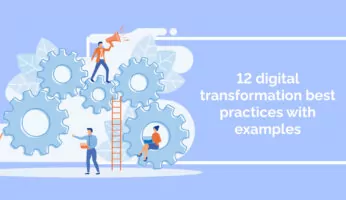
A successful workplace transformation depends on a number of factors, from technology to workflows to management.
In the post-pandemic era, many have begun to realize that workplace transformation is a necessity. For instance, many employees state that they will only work for employers who allow remote working – and that they will quit if their employer refuses to offer it.
Yet workplace transformation goes beyond remote working. New technologies, such as automation, are sweeping through the digital workplace, fueling the need to upskill and cultivate a digitally savvy workforce.
5 Steps to a Successful Workplace Transformation
Here are a few steps to take when embarking on a journey of workplace transformation.
1. Adopt cutting-edge technology
Digital adoption has become an embedded business function in many of the most forward-thinking organizations. Those organizations that want to remain competitive and relevant, in other words, are rapidly implementing and exploiting emerging technology.
Since, in the coming years, today’s innovative technology will become the standard in tomorrow’s economy, staying competitive means staying ahead of the curve and adopting early.
A few technologies to look at include:
- Cloud technology
- Artificial intelligence
- Automation
- Data and analytics
- IoT
Over the coming months and years, these types of technologies will redefined the workplace, so it is important to begin rolling them out now and be ready for the workplace of tomorrow.
2. Leverage modern workflows, business processes, and business tools
Traditional business models and operating models may work well in a stable, slow-moving economy. But during times of constant disruption, it is important to adopt new models.
A few process improvement methodologies that have become popular in recent years include:
- Agile
- Lean
- Six Sigma
- Lean Six Sigma
Processes such as these are built around customer-centrism and continual improvement. These methodologies can continuously enhance quality and performance wherever they are applied.
At the same time, other techniques and business functions can further enhance an organization’s efficiency and agility.
For example:
- Business process management can improve the efficiency and effectiveness of individual processes
- Process mining can assess the gap that exists between an organization’s designed processes and what they actually look like in the real world
- Change management can be used to streamline and improve the outcomes of organizational change initiatives
In short, business managers and leaders should look beyond the workplace at the business as a whole. After all, the workplace is simply one piece of the larger business – when implementing changes to either one, the other should change as well.
3. Cultivate a culture of learning and agility
The workplace consists of more than just processes and technology. People, in fact, lie at the heart of every business.
To ensure that they can actually drive transformation in the workplace and the business, managers should cultivate an organizational culture that supports change and mobility.
A culture of learning, for instance, can:
- Increase agility and adaptability
- Decrease resistance to change
- Speed up the adoption of new tools, technologies, and processes
Continual learning is essential in an era that is continually changing. In fact, not only can it fuel workplace transformation and business transformation, it can become a competitive differentiator and help businesses stay future-ready.
4. Create a consistent employee experience across the hybrid office
The hybrid office refers to a distributed workforce composed of both on site and remote workers. In the past, some have suggested that the future of work will be remote. Yet most of us now realized that the future is hybrid.
While some might argue that hybrid is the end goal of workplace transformation, we could equally argue that successful workplace transformation depends on having the right hybrid setup.
This means:
- Adopting modern remote working software
- Deploying hybrid-friendly office equipment that seamlessly connects onsite and offsite workers
- Monitoring the performance of offsite and onsite employees
- Conducting surveys and polls to gain insight into employees’ needs
- Using remote employee training software to provide employees with the right digital skills
The right hybrid office setup will fundamentally enable other workplace transformation efforts. Hybrid technologies and workflows will make possible the adoption of mobile, digital-first workplaces better more agile and resilient.
5. Implement a digital adoption function in the workplace
As noted above, digital adoption is a fast-growing business function dedicated to deploying new technology, on boarding and training new employees, and maximizing the performance and are alive that technology.
Digital adoption platforms (DAPs) are tools dedicated to this purpose.
Among other things, they:
- Provide contextualized, in-app guidance through software walkthroughs
- Monitor employees’ interactions with their software, which can facilitate process mining and improved business processes
- Simplify and streamline the adoption of digital tools
- Reduce software-related frustration
- Drive up the ROI of software investments
With the right digital adoption strategy and software, employees will be able to more quickly adopt new software and drive digital workplace transformation efforts – and since the future of work is digital, it is important to fully integrate digital tools and strategies into the workplace.
WalkMe Team
WalkMe spearheaded the Digital Adoption Platform (DAP) for associations to use the maximum capacity of their advanced resources. Utilizing man-made consciousness, AI, and context-oriented direction, WalkMe adds a powerful UI layer to raise the computerized proficiency, everything being equal.



